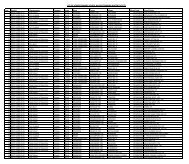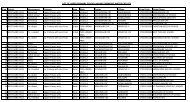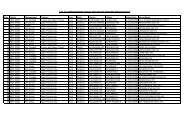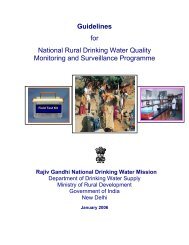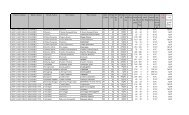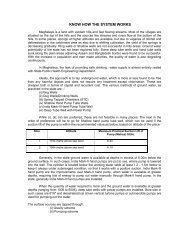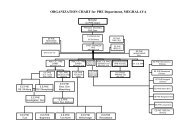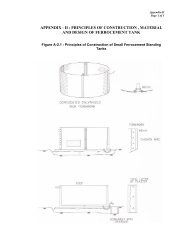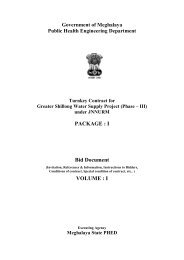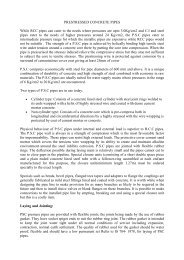PACKAGE : I Bid Document VOLUME : II - Public Health Engineering
PACKAGE : I Bid Document VOLUME : II - Public Health Engineering
PACKAGE : I Bid Document VOLUME : II - Public Health Engineering
Create successful ePaper yourself
Turn your PDF publications into a flip-book with our unique Google optimized e-Paper software.
All excavated materials shall be the property of the Department and shall be<br />
stacked or disposed off as directed.<br />
(b) Preparation of embankment : Material used for embankment shall be<br />
spread in horizontal layers not more than 300mm thick. Each layer shall be<br />
consolidated by watering, ramming and rolling before the next layer is laid.<br />
Mechanical consolidation is recommended. The consolidation obtained shall not be<br />
less than 90 percent of the proctor density in accordance with IS:2720<br />
(Part:7)-1980. Any wash-outs during rains shall be replaced with suitable materials.<br />
The embankment shall be finished to the correct dimensions and gradients<br />
prescribed by the Engineer-in-charge. If banking is to be done on the sloping<br />
ground or on embankment, it shall be cut in steps of not less than 300mm deep and<br />
450mm wide to give a proper bond. Side slopes of the embankment shall be steeper<br />
than 1½ horizontal to 1 vertical. The slopes of embankment should be protected by<br />
pitching or any other method, if so required by the Engineer-in-charge.<br />
Width of embankment : The width of the embankment at top shall be such as to<br />
accommodate the pipe line and the service passage.<br />
Materials for embankment : Materials used for embankment shall be such that it does<br />
not harm the pipe line. It shall not swell when moisture laden or shrink and crack when dry<br />
and shall have self-draining properties. Mud, clay, slush and decaying vegetable matter<br />
shall not be used. The materials shall also be free from cinders, ashes, refuse, rubbish,<br />
organic material, frozen material or material which in the opinion of the Engineer-incharge<br />
is unsuitable or deleterious. All lumps and clods shall be broken to allow uniform<br />
subsidence of the earth work throughout the embankment.<br />
Stability of embankment – Embankment shall rest on good foundation which shall be<br />
capable of taking load of the earth fill, the pipe line, service road, etc. when embankment is<br />
laid on soft ground, such as marshy clay or marine clay, such soft foundation shall be<br />
stabilized by providing sand piles or rubble piles. In the alternative, RCC or wooden piles<br />
should be driven to transfer load to harder substrata.<br />
Pipe handling and inspection:<br />
1. Preliminary work before pipe laying.<br />
(a) Bench Marks : Reference bench marks, at least one per kilometer, shall be<br />
fixed before the work of laying the pipe line is started. These bench marks should<br />
be fixed a little away from the field of work and should securely fixed in cement<br />
concrete.<br />
(b) Transporting and stacking of pipes : Delivery of the pipes shall be taken<br />
from the stockyard at Mawphlang and transported to the site of laying and stacked<br />
along the route. Suitable gaps in the pipes stacked should be left at intervals to<br />
permit access from one side to the other.<br />
DTS : Detailed Tender Specification. Page 169



